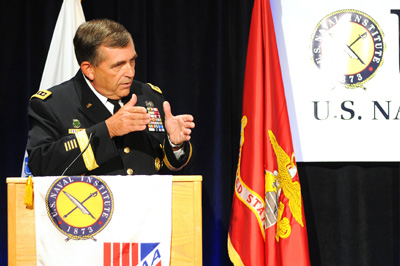By C. Todd Lopez
WASHINGTON (Sept. 26, 2011) -- Prescription drug abuse among wounded warriors has decreased since the Army Pain Management Task Force was founded two years ago, said the Army's vice chief of staff.
A drop in narcotics use was the good news Gen. Peter W. Chiarelli related as he discussed the high number of Soldiers suffering from post-traumatic stress, or PTS, and traumatic brain injury, or TBI, during his keynote speech today at the 2011 Defense Forum Washington seminar "The Journey Back: Helping Wounded Warriors and their Families Transition."

As of Sept. 1, just more than 8,900 Soldiers were part of the Wounded Warrior Program, he said. Of those, just under 4,500 suffered from PTS, and just under 1,500 suffered from TBI.
"These are "the signature wounds of this war," said Chiarelli. And he added that more Soldiers are likely suffering, but have not yet been diagnosed. "We must get a handle on this," he said.
Advancements have been made though, he said, in dealing with one problem facing wounded warriors: prescription drug abuse. The Army Pain Management Task Force has created new guidelines, he said, to ensure fewer Soldiers are able to become addicted to prescription drugs.
"These important changes have led to a decreased use of prescription medications," he said. Specifically, there have been reductions in the use of narcotics and psychotropic drugs.
At Walter Reed's Warrior Transition Unit, narcotics usage went down from 80 percent to 8.5 percent among wounded warriors, he said. The general said the Army would like to replicate that success at all Army installations, but there is a shortage of those trained in alternative pain management.
The Army Pain Management Task Force was chartered in 2009 to look at alternative ways to treat pain, including such things as yoga, meditation and acupuncture, for instance. Prescription records for Soldiers are also now tracked by Defense-wide electronic databases.
"My number-one priority is the health and well-being of the force," Chiarelli said. While issues such as cost savings and the Army's network are also important, he said that unlike the Air Force and the Navy, where platforms such as aircraft and naval vessels are critical -- the Army is "people-centric."
"The rest simply won't matter if our people aren't cared for properly," Chiarelli said.
Chiarelli also expressed concern to seminar attendees about the complexity of and the speed at which Soldiers move through the Integrated Disability Evaluation System, or DES. After a decade of war, he said, there are about 20,000 Soldiers in the system. Those are Soldiers who are not able to deploy, he said, adding that the number of Soldiers in the system has increased about 169 percent since January 2008.
"The reality is that number is probably closer to double that factor if you figure in the number of Soldiers who are not yet enrolled in DES, but are none-the-less non-deployable, with either temporary or permanent medical profiles."
Some of those, he said, will get a permanent profile, for up to 6 months, and they will heal and be able to go back into a deployable status. Others will not, he said. Others will remain un-deployable, and enter the DES.
"When you take 40,000 Soldiers out of the end strength of the U.S. Army -- that is one of the effects of 10 years of war."
Getting an active-duty Soldier though the system takes about 373 days now, he said. "Needless to stay, this is too long. The system is complex, disjointed and confusing. DOD is continuing to work closely with the Department of Veterans Affairs, along with military services, to make needed improvements."
Inside the Army's Wounded Warrior Program, about two-thirds of Soldiers are suffering from either post-traumatic stress or traumatic brain injury, Chiarelli said.
Both TBI and PTS produce symptoms like concentration problems, irritability, personality changes and memory impairment, Chiarelli said, also saying it's important to learn the difference between the two. "We need to understand how to differentiate between them and how to effectively treat them."
One challenge with both PTS and TBI is the latency of symptoms -- the time between when an injury occurs that causes them, and when the symptoms present themselves. After that, there is even time before somebody suffering from the two injuries is first treated.
Chiarelli reported a statistic from the National Institute of Health that the average time between injury and first treatment is 12 years. "A bunch of bad stuff happens in that 12-year interval," he said.
With the drawdown in Iraq and Afghanistan, more Soldiers will be coming home, and some will stay home 12-14 months. Many of those, he said, will be dealing with physical and behavioral health issues -- including depression, anxiety, TBI and PTS.
Of particular concern are Soldiers in the Army Reserve and the Army National Guard. Unlike their active-duty counterparts, those Soldiers do not stay on a military installation or a military community after they return from overseas.
"The reality is we are able to more effectively influence those Soldiers serving on active duty," Chiarelli said. Soldiers in the reserve components are isolated from military support structures, including their command structure and mental health facilities. And isolation from the military community and support is now exacerbated by the concerns that come with the declining economy, he said.
"We are not going to rest until we figure out how to bridge the divide of the reserve component," he said.